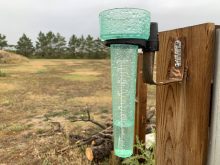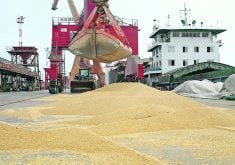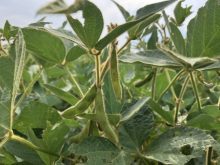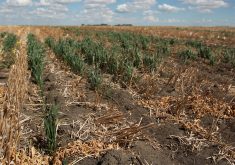Specialists say the crop is a ‘sub-tropical species’ that likely can’t reach four to five million acres in Western Canada
Not long ago, soybean advocates were expecting the crop to reach four to five million acres in Western Canada.
After several years of drought, industry experts are now saying that soybeans can still perform on the Prairies, but likely on a smaller number of acres.
“I think Manitoba will probably end up at 1.5 to 1.7 million (acres), long term,” said Dennis Lange, the pulse crop and soybean specialist with Manitoba Agriculture. “That’s my thought, with the odd bump years, where you have better prices…. But time will tell.”
Lange made his comments at the Manitoba Agronomists Conference, an event held every December at the University of Manitoba.
The topic of Lange’s presentation was the evolution of soybean production. Joining him on stage was Horst Bohner, a soybean expert with the Ontario Ministry of Agriculture, Food and Rural Affairs.
Manitoba’s soybean acreage reached a peak of 2.3 million in 2017. In that same year, Saskatchewan farmers seeded around 800,000 acres. Acreage was expected to climb, possibly hitting three million in Manitoba and a couple of million in Saskatchewan.
However, dry years in 2017-19 put a lid on yields and expansion.
Farmers in Saskatchewan and western Manitoba reported yields of 20 bushels per acre or less. Consequently, many producers gave up on beans, which need rain in late July and August.
“The rest of our cropping structure is set up for that dry August, which is what we usually get,” Rob Stone, who farms near Davidson, Sask., said last year.
“But soybeans need the opposite. They’re a nice hedge, but statistically we get drought conditions at the wrong time for soybeans to work out.”
Climate statistics show that Stone is correct. Saskatchewan doesn’t get enough rain for a crop like soybeans:
- London, Ont., average annual precipitation, 961 mm
- Estevan, Sask., average, 454 mm
- Carman, Man., 545 mm
Bohner and Lange were polite when talking about the potential of soybeans in Saskatchewan, which possibly had 40,000 to 60,000 acres of beans this year.
The implied message was that the short growing season and lack of rainfall are massive challenges.
“You have to think about your yield limiting factor. Soybeans are a sub-tropical species…. They are a long season, warm season crop,” Bohner said.
“The breeders have come a long way, but that is your limitation.”
Agriculture Canada researchers and university plant breeders have tried to develop soybeans with more tolerance to drought, but it’s been a difficult task, Bohner said.
“Something like 80 percent of soybean roots are in the top three inches (of soil),” he said. “If that is powder dry, you’re not getting anything in that plant. No nutrients…. There is no answer to that, other than more water.”
While massive expansion seems unlikely, soybeans have been a major success story in Manitoba. Around 2009, farmers seeded less than 500,000 acres in the province and average yields were just above 30 bu. per acre.
In 2022, Manitoba set a record with average yields of 45 bu. per acre, which is close to yield figures from Ontario.
“(That) 45 was a big number for Manitoba,” Lange said. “We had almost perfect conditions in 2022 for moisture and there wasn’t a lot of stress.”
Manitoba farmers planted about 1.5 million acres of soybeans in 2023, making it the third largest crop in the province after canola and wheat.
Yields, however, were down this year.

It was drier in much of Manitoba and the provincial average will likely be 34 bu., Lange said.
In Ontario, 2023 was a fantastic growing season for soybean producers. They set a provincial record of 53 bu. per acre.
Yields in the 50s and 60s should encourage more soybeans in the future, but there are limits to acreage expansion in the province.
Over the last few years, Ontario farmers planted about three million acres of beans.
“Can we make it to four million?” Bohner said. “It will take a long time.”
It’s possible that soybeans will steal acres from pasture and hayland. Plus, clearing in northern regions could create more farmland.
But Ontario farmers are losing acres to a pervasive trend.
“The biggest challenge we have… is not invasive pests or weeds. Not soil erosion. Not climate change. The biggest challenge we have is urbanization,” Bohner said.
The Ontario Farmland Trust estimates that the province has lost 2.8 million acres of agricultural land to urbanization and aggregate mining in the last 35 years.
Other estimates suggest that Ontario loses 175 acres of farmland every day to new housing developments and urban expansion.
















